23 results
Family involvement, patient safety and suicide prevention in mental healthcare: ethnographic study
-
- Journal:
- BJPsych Open / Volume 9 / Issue 2 / March 2023
- Published online by Cambridge University Press:
- 23 March 2023, e54
-
- Article
-
- You have access
- Open access
- HTML
- Export citation
Liaison psychiatry practitioners’ views on accessing aftercare and psychological therapies for patients who present to hospital following self-harm: multi-site interview study
-
- Journal:
- BJPsych Open / Volume 9 / Issue 2 / March 2023
- Published online by Cambridge University Press:
- 20 February 2023, e34
-
- Article
-
- You have access
- Open access
- HTML
- Export citation
Contributors
-
-
- Book:
- Organising Music
- Published online:
- 05 January 2015
- Print publication:
- 05 February 2015, pp xii-xxviii
-
- Chapter
- Export citation
Contributors
-
-
- Book:
- Acute Care and Emergency Gynecology
- Published online:
- 05 November 2014
- Print publication:
- 30 October 2014, pp ix-xiv
-
- Chapter
- Export citation
6 - Commercial nutritional enteral and parenteral formulations in critical care
- from Section 2 - Nutritional Delivery and Dietetics
-
-
- Book:
- Nutrition in Critical Care
- Published online:
- 05 April 2014
- Print publication:
- 06 March 2014, pp 53-66
-
- Chapter
- Export citation
List of contributors
-
-
- Book:
- Nutrition in Critical Care
- Published online:
- 05 April 2014
- Print publication:
- 06 March 2014, pp viii-xii
-
- Chapter
- Export citation
Authors' reply
-
- Journal:
- The British Journal of Psychiatry / Volume 201 / Issue 2 / August 2012
- Published online by Cambridge University Press:
- 02 January 2018, p. 160
- Print publication:
- August 2012
-
- Article
-
- You have access
- HTML
- Export citation
Contributors
-
-
- Book:
- Core Topics in Cardiac Anesthesia
- Published online:
- 05 April 2012
- Print publication:
- 15 March 2012, pp x-xiii
-
- Chapter
- Export citation
Chapter 9 - Inotropes and vasoactive drugs
- from Section 2 - Cardiac pharmacology
-
-
- Book:
- Core Topics in Cardiac Anesthesia
- Published online:
- 05 April 2012
- Print publication:
- 15 March 2012, pp 48-56
-
- Chapter
- Export citation
Trends in national suicide rates for Scotland and for England & Wales, 1960–2008
-
- Journal:
- The British Journal of Psychiatry / Volume 200 / Issue 3 / March 2012
- Published online by Cambridge University Press:
- 02 January 2018, pp. 245-251
- Print publication:
- March 2012
-
- Article
-
- You have access
- HTML
- Export citation
Abbreviations
-
- Book:
- Anaesthetic and Perioperative Complications
- Published online:
- 07 October 2011
- Print publication:
- 22 September 2011, pp xi-xiv
-
- Chapter
- Export citation
Contributors
-
-
- Book:
- Anaesthetic and Perioperative Complications
- Published online:
- 07 October 2011
- Print publication:
- 22 September 2011, pp ix-x
-
- Chapter
- Export citation
Section 3 - Ethical and medico-legal complications
-
- Book:
- Anaesthetic and Perioperative Complications
- Published online:
- 07 October 2011
- Print publication:
- 22 September 2011, pp 201-209
-
- Chapter
- Export citation
Section 2 - Clinical aspects of complications
-
- Book:
- Anaesthetic and Perioperative Complications
- Published online:
- 07 October 2011
- Print publication:
- 22 September 2011, pp 23-200
-
- Chapter
- Export citation
Anaesthetic and Perioperative Complications - Title page
-
-
- Book:
- Anaesthetic and Perioperative Complications
- Published online:
- 07 October 2011
- Print publication:
- 22 September 2011, pp iii-iii
-
- Chapter
- Export citation
Copyright page
-
- Book:
- Anaesthetic and Perioperative Complications
- Published online:
- 07 October 2011
- Print publication:
- 22 September 2011, pp iv-iv
-
- Chapter
- Export citation
Section 1 - Generic aspects of complications
-
- Book:
- Anaesthetic and Perioperative Complications
- Published online:
- 07 October 2011
- Print publication:
- 22 September 2011, pp 1-22
-
- Chapter
- Export citation
Index
-
- Book:
- Anaesthetic and Perioperative Complications
- Published online:
- 07 October 2011
- Print publication:
- 22 September 2011, pp 248-257
-
- Chapter
- Export citation

Anaesthetic and Perioperative Complications
-
- Published online:
- 07 October 2011
- Print publication:
- 22 September 2011
Anaesthetic and Perioperative Complications - Half title page
-
- Book:
- Anaesthetic and Perioperative Complications
- Published online:
- 07 October 2011
- Print publication:
- 22 September 2011, pp i-ii
-
- Chapter
- Export citation



